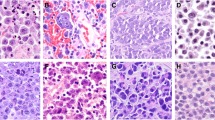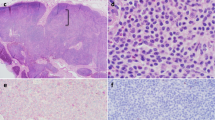Abstract
Among 276 canine lymphomas referred to the Haematology–Cytology–Immunology laboratory of the Lyon Veterinary School between 1997 and 2003, there were five aggressive large granular lymphocyte (LGL) malignancies. The five dogs were clinically examined and followed up. Cytological and histological analyses of the liver, spleen, lymph nodes, intestine and bone marrow were performed. The immunophenotype and proliferation index were established. The most significant clinical finding was that of an aggressive clinical course, the presence of hepatomegaly and/or splenomegaly, an abdominal lymphadenopathy, anaemia in four cases and blood and bone-marrow involvement in two cases. The cytological presentation was a diffuse infiltration of atypical, large granular lymphoid cells. Two cases were of the null type (CD3−, CD79a−, CD4−, CD8−), and three were of the T-cell type (CD3+, CD79a−, CD4−, CD8+). The proliferation index was high in all cases, with a median of 54.4%. The histological presentation of the null-type cases was an infiltration of the liver’s portal triads and the spleen’s red pulp. The T CD8+ cases showed two different patterns, characterised by infiltration: in the first, of all the intestine’s layers, the liver’s portal triads, the spleen’s red pulp and the lymph nodes and, in the second, infiltration of the liver’s sinusoids, the spleen’s red pulp. Although these aggressive LGL lymphomas are still poorly known, they may be compared to three types of human lymphoma: aggressive NK cell lymphoma/leukemia, hepatosplenic T-cell lymphoma and enteropathy-type T-cell lymphoma.












Similar content being viewed by others
References
Brousse N, Lavergne A (1997) Lymphome digestifs aspects anatomo-pathologiques. In: Solal-Céligny P, Brousse N, Fermé C, et al (eds) Lymphomes, lymphomes non Hodgkiniens-maladie de Hodgkin. Frison-Roche, 3rd edn. Aubin Press, Poitiers, pp 334–347
Brousse N, Solal-Céligny P, Gaulard P (1997) Lymphomes hépatiques et spleniques. In: Solal-Céligny P, Brousse N, Fermé C, et al (eds) Lymphomes, lymphomes non Hodgkiniens-maladie de Hodgkin. Frison-Roche, 3rd edn. Aubin Press, Poitiers, pp 419–425
Cienava EA, Barnhart KF, Brown R, et al (2004) Morphologic, immunohistochemical, and molecular characterization of hepatosplenic T-cell lymphoma in a dog. Vet Clin Pathol 33:105–110
Cooke CB, Krenacs L, Stetler-Stevenson M, et al (1996) Hepatosplenic T-cell lymphoma: a distinct clinicopathologic entity of cytotoxic γδ T-cell origin. Blood 88:4265–4274
Farcet JP, Gaulard P, Marolleau JP, et al (1990) Hepatosplenic T-cell lymphoma: sinusal/sinusoidal localisation of malignant cells expressing the T-cell receptor γδ. Blood 75:2213–2219
Felman P, Gentilhomme O (1997) Lymphomes à cellules T péripheriques ou NK. In: Felman P, Gentilhomme O (eds) Atlas de cytopathologie ganglionnaire. Arnette S.A, Paris, pp 75–88
Ferrer L, Fondevila D, Rabanal R, et al (1992) Detection of T-lymphocytes in canine tissue embedded in paraffin wax by means of antibody to CD3 antigen. J Comp Pathol 106:311–314
Fournel-Fleury C, Magnol JP, Chabanne L, et al (1997) Growth fractions in canine non-Hodgkin’s lymphomas as determined in situ by the expression of the Ki-67 antigen. J Comp Pathol 117:61–72
Franks PT, Harvey JW, Calderwood M, et al (1986) Feline large granular lymphoma. Vet Pathol 23:200–202
Fry MM, Vernau W, Pesavento PA, et al (2003) Hepatosplenic lymphoma in a dog. Vet Pathol 40:556–562
Gentile TC, Uner AH, Hutchison RE, et al (1994) CD3+, CD56+ aggressive variant of large granular lymphocyte leukemia. Blood 84:2315–2321
Ghernati I, Corbin L, Chabanne L, et al (2000) Canine large granular lymphocyte leukemia and its derived cell line produce infectious retroviral particles. Vet Pathol 37:310–317
Greer JP, Kinney MC, Loughran TP (2001) T cell and NK cell lymphoproliferative disorders. Hematology 2001:259–281
Jaffe ES (1996) Classification of natural killer (NK) and NK-like T-cell malignancies. Blood 87:1207–1210
Jaffe ES, Ralfkiaer E, Chan WC, et al (2001) Mature T-cell and NK-cell neoplasms. In: Jaffe ES, Harris NL, Stein H, et al (eds) World Health Organization classification of tumours. Pathology and genetics of tumours of haematopoietic and lymphoid tissue. IARC Press, Lyon, pp 189–235
Jones M (1993) Peptide immunization as a source of cross-species reactive antisera recognizing leukocyte differentiation antigens. Immunological reagents for the study of disease in companion animals. Wellcome Trust, London
Kariya K, Konno A, Ishida T (1997) Perforin-like immunoreactivity in four cases of lymphoma of large granular lymphocytes in the cat. Vet Pathol 34:156–159
McDonough SP, Moore PF (2000) Clinical, hematologic and immunophenotypic characterization of canine large granular lymphocytosis. Vet Pathol 37:637–646
Otani I, Niwa T, Tajima M, et al (2002) CD56 is expressed exclusively on CD3+ T lymphocytes in canine peripheral blood. J Vet Med Sci 64:441–444
Valli VA, Jacobs RM, Parodi AL, et al (2002) Histological classification of hematopoietic tumors of domestic animals. Armed Forces Institute of Pathology, 2nd series, vol III, Washington, pp 40–42
Vernau W, Moore PF (1999) An immunophenotypic study of canine leukemias and preliminary assessment of clonality by polymerase chain reaction. Vet Immunol Immunopathol 69:145–164
Walton RM, Modiano JF, Thrall MA, et al (1996) Bone marrow cytological findings in 4 dogs and a cat with hemophagocytic syndrome. J Vet Intern Med 10:7–14
Wellman ML (2000) Lymphoproliferative disorders of large granular lymphocytes. In: Feldman BF, Zinki JG, Jain NC (eds) Schalm’s Veterinary Hematology, 5th edn. Lippincott, Williams and Wilkins, Baltimore, pp 642–647
Author information
Authors and Affiliations
Corresponding author
Rights and permissions
About this article
Cite this article
Turinelli, V., Marchal, T., Ponce, F. et al. Aggressive large granular lymphocyte lymphomas in five dogs: a clinical cytohistological and immunological study. Comp Clin Path 13, 109–118 (2005). https://doi.org/10.1007/s00580-004-0531-5
Received:
Accepted:
Published:
Issue Date:
DOI: https://doi.org/10.1007/s00580-004-0531-5




